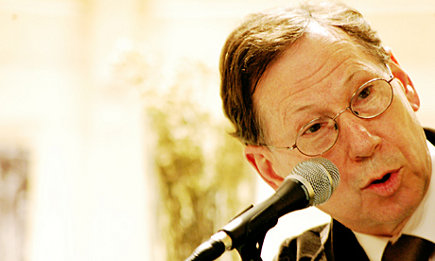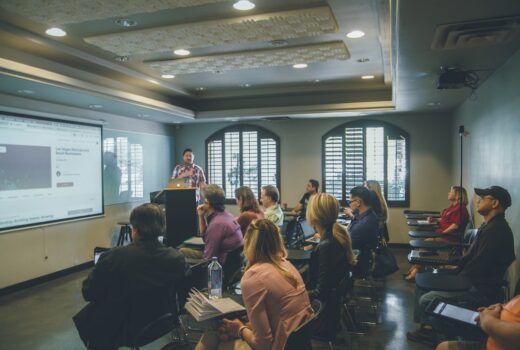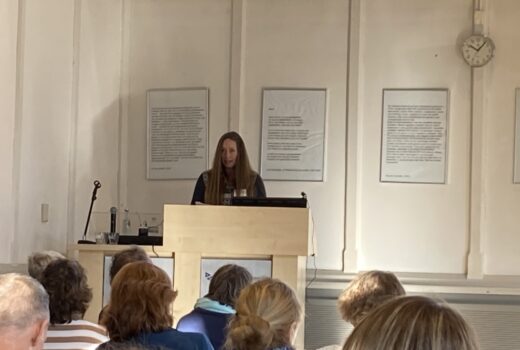Maak NWO Europees mechanisme

Soete gooide een flinke knuppel in het hoenderhok van de discussie over de Wetenschapsvisie en het advies Van der Steenhoven. “Als er in Europa nu één gebied is waar subsidiariteit actuele betekenis heeft, dan is het wel in de verdeling en allocatie van onderzoeksgelden. Dat blijkt uit de oprichting van de ERC en de substantiële stijging van de financiering van onderzoek vanuit Horizon 2020, namelijk een stijging van 60%, zo’n €1,7 miljard in 2014. Dus minder subtiel gezegd, ik ben van mening dat NWO moet worden afgeschaft en worden geïntegreerd binnen de ERC, met een ‘juste retour’ clausule voor Nederlandse onderzoekinvesteringen.”
Een zuivere win-win
“Dit moet gedaan worden binnen het strategische investeringsinitiatief van Juncker. Dit betekent dat de grote onderzoekinfrastructuur niet langer meetelt bij de meting vanuit het Groei en Stabiliteitspact van de Unie en dus niet meetelt bij de -3% norm voor de overheidstekorten. Een zuivere win-win situatie.”
U leest hieronder de hele speech van rector magnificus Luc Soete bij de Maastrichtse Dies.
“Ladies and gentlemen, invited and distinguished guests, Members of the Supervisory Board, Governor of the Province of Limburg, Mayor of the city of Maastricht, representatives of Belgium, Poland, Ghana and Ukraine, colleagues, students: a hearth felt welcome at this year’s Dies Natalis, in which we celebrate this university’s 39th birthday.
This is the third time I stand here on this pulpit in the Sint-Jan’s church, and it is still as difficult as ever to mount these steps dressed up in this gown…
The first time was exactly 25 years ago when I was asked to give the university’s 14th Dies Natalis lecture of what was then still called the Rijksuniversiteit Limburg. The title of my talk was: “The future isn’t what it used to be”, not a particularly original title[1], but one that seemed particularly appropriate in those first days of 1990 with the coming to an end of the Iron Curtain and the expectations of what this radical change could bring about in Europe.
The second time was 2.5 years ago, when I delivered from this same pulpit my acceptance speech as Rector Magnificus designate. The title of my speech was “Maastricht University” with a c not an s: how Maastricht could (again) become a university city.
This is also the third time I have the pleasure of welcoming you as Rector Magnificus at the Dies Natalis of our university: today its 39th birthday.
University as growth engine
In my first welcoming speech at the Vrijthof Theatre, two years ago, I emphasized the particular role and responsibility of the university as growth engine of new economic value, employment and more broadly development for the region. That role of engine of growth became, I argued, more pronounced in the aftermath of the financial crisis with its accompanying decline in private investment, its rise in bankruptcies, distrust in future opportunities and rapid growth in unemployment.
To be, or rather pretend to be, in the process of becoming an elite university – a “Harvard on the Maas” as some would put it[2] – limiting the number of admitted students to a selected few, wasn’t just against the spirit of our student-centred education system, it was also not in line with the changing environment within which the university found itself operating. As our first, societal Doctor Honoris Causa, DSM CEO Feike Sybesma, put it: “one cannot achieve success in an environment dominated by failure.”
Knowledge transfer in the region
Exploiting the university’s underutilized growth potential was hence, for me at least, a must. Two years later, and with the help of the provincial authorities, we are now together with our local partners: the Academic Hospital and Zuyd University of Applied Sciences involved in a ten-year growth programme investing in the further development of new higher education programmes, research fields and institutes and knowledge transfer in the region.
Not, Mister Timmermans, the size of Jean-Claude Juncker strategic investment plan, and, if I may add, not expecting a similar leverage effect in raising additional private funds but a strategy which looks remarkably similar to what the new Commission initiated a couple of months ago and will be implementing this year.
Last year during the 38th Dies, I discussed the rapid internationalisation in the research process itself[3]. That process raises many challenges: fast, too fast, pressures on realizing research output; an obsession with output metrics; strategic behaviour with in some cases perverse incentives and last but not least increasingly poor career prospects for young researchers whose predicament I compared with members of a drug gang. In short, what I understood as science being “in transition”.
Last year the Dutch government published its long awaited 2025 Vision on Science which immediately faced a lot of critique both in the press and within the scientific community, particularly with respect to the proposed changes in the governance of NWO, the Netherlands Organisation for Scientific Research.
For sure, it will continue to be at the forefront of much debate in the coming months with the forthcoming Science Agenda which will be presented later this year. The VSNU, the Dutch universities’ [cartel] association already reacted to the government’s science vision[4]. My own, personal view differs from that of the VSNU. For me, one of the reasons why Europe has not kept up with the high Lisbon expectations in research and innovation over the last decade has everything to do with the dominance within Europe of small countries, and hence of small research budgets. The total budget of NWO is with 650 million less than what the British Welcome Trust spends annually on just medical research and innovation.
And yet with this amount, the Netherlands has the sixth largest European public science budget. Furthermore, in some European member states, there are countries with regional research budgets… Thus the annual budget of the Flemish FWO is e.g. 200 million euro’s, four times that of the Luxembourg FNR of 50 million euro’s. To imagine that one could just add up all those different national and regional science budgets representing total “European” research efforts comparable to US, Chinese or even German or British efforts, is to ignore completely the local idiosyncrasies surrounding national research funding in Europe.
Juste retour
If there is one area where subsidiarity has actually a meaning it is in the distribution and allocation of research funds, as reflected in the creation of the ERC and the substantial increase in its funding within Horizon 2020, an increase of 60% representing in 2014 some 1.7 billion[5]. So to put it mildly, I’m not impressed by the letter of the 72 Dutch Spinozists in defence of the current organizing structure of NWO. To put it less mildly: in my view NWO should really be abolished and integrated within the ERC with a “just retour” clause for Dutch research funding efforts.
Doing so within the Juncker Strategic Investment initiative, could even imply that NWO’s large research infrastructure investments would no longer be taken into account in the Stability and Growth Pact assessment and hence become excluded from the 3% budgetary norm. A pure win-win… but I didn’t intend to discuss the future of Dutch research funding and its organization in any detail here, and I already spend far too much time on the issue.
Bread and butter
In this year’s Dies, I would like to focus on education. Ultimately, the bread and butter of what we are here for. An area where, if you allow me the non-scientific use of medical terms, one may wonder whether universities too are not suffering from ‘spiritual Alzheimer‘: forgetting what they are here first and foremost for: contributing to the academic education and formation of students.
An area which in these post-Charlie days highlights quite suddenly our particular role as university as “bastion of openness, freedom of thought and freedom of speech” to quote our strategic programme[6], but also, if I may add, as higher education establishment in engaging students in standing for scientific debate, tolerance and respect for others’ opinions. It is no surprise that education as inclusive activity[7] and prisons [and incarceration] as excluding activity stand each, in opposing ways, at the forefront of the Charlie debate.
Raison d’être
Engaging students appears also a key factor in explaining the high study success figures we obtain here in Maastricht compared to other universities in The Netherlands and elsewhere in Europe. Engaging students was actually one of the main ‘raison d’être’ for the Rijksuniversiteit Limburg, when it was set up within a spirit of the need for educational renewal also in higher education in the 70’s.
Our problem-based learning (PBL) system originally taken over from McMaster University was indeed a pretty radical innovation in the teaching of medicine in The Netherlands. Today it has become standard practice in most other medical schools and departments in the world, even Harvard and the other Dutch Harvard on the Meuse…
Knowledge Engineering
Rotterdam. But as only university in the Netherlands, we implemented PBL teaching across all disciplines as a common education philosophy, making education first and foremost a student-centred activity, in short engaging students. Over the last decade it led to several incremental innovations and improvements such as the Leading in Learning micro-projects initiated by my predecessor, Gerard Mols, and the Learning@Work programme implemented within the study programme of Knowledge Engineering[8] aimed at fostering work experience within education.
Innovation in education, such as PBL does, however, not allow itself to be structured and routinized in a timeless fashion. With the emergence of MOOCs, with the word “massive” in the acronym at first sight going in the exact opposite direction of our PBL student-centred education system, the question raised already three years ago by Wim Gijselaars in his Dies lecture of 2012 about the balance between the internal access to the knowledge within the group of students and the tutor, and the outside knowledge available at the hands of a digital click has become much more pressing. How can and should we reform a closed student centred and location based education system in a world, to use Jimmy Wales’ words, “in which every single person on the planet is given free access to the sum of all human knowledge”[9]?
Discussing the particular problem
Keeping pace with this extraordinary proliferation of information, of software tools, mobile apps is challenging for students and teachers alike. For students it effectively means that the massive amount of information, comments, reflections, outside of the student group is likely to be more valuable in discussing the particular problem issue in the PBL session than the comments of colleague students and even the tutor. For teachers and educators, the question is how one can truly add to such open access to knowledge in terms of actual learning, sense-making, coaching, and credentialing?
In short: how a new, adapted PBL 2.0 can surmount the simple access to internet in obtaining information and new facts and become a truly learning process. As Sparrow et al. (2011) pointed out in a study on the effects of Google on memory, “processes of human memory are adapting to the advent of new computing and communication technology … we are learning what the computer ‘knows’ and when we should attend to where we have stored information in our computer-based memories.”[10]
Open to all
Developing under such conditions a new PBL 2.0 will be a tough task, actually a much tougher one than the setting up of a successful MOOC. The latter represents to some extent the digital form of “best practice” education performance: a carefully, well-structured and regularly assessed on-line course allowing for stepwise progress, with the course programme given by a gifted teacher using all available visual and audio support systems, ‘open to all’. As the success in attracting large number of students to follow such courses is witness too, the MOOC’s road to increase a university’s market share appears to many universities both in The Netherlands, and in the world, the ideal strategy to navigate the higher education perfect storm. Not though for the UM.
At first sight our challenge looks more like the opposite. How to realize an ideal internalization of knowledge within student group discussions exploiting optimally the massive external knowledge available on each one’s mobile, i-pad, notebook or laptop. This can only be addressed through experimenting, through trial and error, as was initiated through the many ‘leading in learning’ micro-projects which have been carried out over the last five years. Now the challenge is to upscale those best practice examples to become the building blocks of the PBL 2.0 of our university and to implement them across all faculties.
Like a prayer
A complex process but one which is, in my view, essential. A decade ago, the logo of our university ‘leading in learning’ was chosen. Whatever one may think of logo’s in the academic community which make self-claims, it is clear that while the claim might well have been correct at the time of its introduction, it is today being challenged. My colleague, Martin Paul made a brave attempt two years ago to interpret the logo as something to remind each one of us every morning – like a prayer – that this was our mission: in my terms a daily dose against educational spiritual Alzheimer. Well, if it worked it didn’t really become visible.
So educational renewal will remain in the years to come a core challenge. To start experimenting how this can be further developed, we have created EdLab – the UM Institute for Education Innovation – which will be located on the Tapijnkazerne and will explore the broad spectrum of opportunities for further renewal and improvement of PBL education. The involvement and engagement of students will lie at the heart of the EdLab initiatives and experiments but EdLab will also require full engagement from teachers, researchers, managers and support staff.
Structure of courses
Ladies and gentlemen, our university is nearly 40 years old: a university still younger than the average age of its staff. We do have, contrary to much older universities, the institutional flexibility to change priorities as they evolved over the last three decades. Thus, in the very early years of the creation of our first new faculty, the faculty of medicine back in the mid-seventies most attention went to education, to the structure of courses, the development of the curricula, the challenge of the implementation of the problem based learning system.
Exactly, as I witnessed with the creation of the Faculty of Economics some ten years later. Yet after a couple of years the focus shifted towards research, in the case of the faculty of medicine cardiovascular research. Thus the first, early researchers were often freed from education so as to get off to a quick start and spend most of their time setting up the new research labs. Gradually the focus within the faculty shifted towards the need for growth in research.
Education was good enough
The general feeling was that education was good enough and that with our unique Maastricht approach we were untouchable. Gradually a schism emerged between research and education. In the case of our medical faculty e.g., a large part of researchers and clinical specialists found spending time on education increasingly a waste of time and considered themselves too good (and too expensive) for education.
I got this from the recent presentation before the KNAW of our Dean of FHML, Albert Scherpbier, but it is actually also what I witnessed when joining the newly created Faculty of Economics in 1986. As a young international economist very much aware of his own opportunity costs of being in Maastricht, I quickly discovered that PBL education represented indeed an expensive burden on my time and moved quickly to create a research institute where I could free myself from the burden of education.
I limit myself
The growing divide between research and education is to some extent characteristic of the early, rapid growth of successful new universities. The emphasis moves sheer naturally to research to establish more firmly the international reputation and ranking of the university. And CARIM, NUTRIM, GROW, MHENS, CAPHRI, MERIT, ROA, METRO, and the many other institutes which received less inventive acronyms over the last thirty years have dramatically contributed to the international reputation of Maastricht university. And hopefully so will Merlin, Mi5 – I limit myself to the new institutes with creative acronyms – in the future.
But this growing divide between research and education is not sustainable. Separated neither the quality of research, nor the quality of education will be sufficiently strong to survive. So our search as university is on for a more balanced approach.
For instance in offering more attractive career perspectives for staff more interested and involved in teaching and more broadly the training of students; or in convincing researchers and the research institutes in which they work to be active in education. I bet – as I experienced myself, when as a director of a research institute, I had the opportunity to integrate one of Maastricht University’s graduate schools – they will be keen on doing so if only because of the scouting of new talent.
Challenges which appear
Ladies and gentlemen, I have laid out here what are some of the challenges in the field of education which we as Maastricht University will be confronted with in the years to come. Challenges which appear at first sight complex and not that easy to address, but challenges which represent little compared to the challenges universities and educational establishments are confronted with in other parts of the world.
Let me in concluding, draw your attention and ask for your support for the Midwifery School in Makeni, Sierra Leone. A new school which with the help of Cord Aid and together with the Academy of Midwifery of Zuyd, we assisted in the development of the curriculum, the educational system and the training of staff. At this moment the Ebola crisis is dramatically affecting the school after having lost several of their health personnel as a result of the Ebola infection. How not to understand the frustration of the Director’s school when being confronted with healthcare workers being infected because of the lack of protective equipment? And how much more “real” than the adjustment, and rebalancing problems I allowed myself to entertain you with here from this pulpit.
[1] After Paul Valéry “L’avenir est comme le reste: il n’est plus ce qu’il était” in “Notre Destin et Les Lettres”, 1937.
[2] Unfortunately there are at least two other Dutch, and several other Belgian universities “on the Maas” with similar ambitions
[3] initially referred to as e-science, later on as science 2.0 and today as “open science”.
[4] As a member of the Dutch Advisory Council on Science, Technology and Innovation, I also had the opportunity to reflect on the future of Dutch science Policy, see AWTI report “Boven het maaiveld”, 2014.
[5] over the period 2014-2020: 13.1 billion.
[6] See Maastricht University Strategic programme “Inspired by quality”, 2012.
[7] as emphasized by many Muslim participants in the Charlie debate mayor Onno Hoes and myself were asked to open last Monday, with appeals for help.
[8] Within the framework of the tUL. Intersting to note that our sister Limburg university, the University of Hasselt is the Flemish university which renewed in a similar fashion Flemish higher education with similar positive results with respect to study success.
[9] Robin “Roblimo” Miller, Slashdot (28 July 2004)
[10] Sparrow, B., Liu, J., & Wegner, D.M. (2011). Google Effects on Memory: Cognitive Consequences of Having Information at Our Fingertips. Science, 333, No. 6043, 776-778.
Meest Gelezen
Vrouwen houden universiteit draaiende, maar krijgen daarvoor geen waardering
Wederom intimidatie van journalisten door universiteit, nu in Delft
‘Burgerschapsonderwijs moet ook verplicht worden in hbo en wo’
Raad van State: laat taaltoets nog niet gelden voor hbo-opleidingen
Hbo-docent wil wel rolmodel zijn, maar niet eigen moreel kompas opdringen



